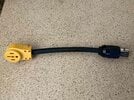My car is going to be spending time in marinas the next several months and it would be nice to charge the car while it's parked there. I have a NEMA 14-50 adapter for my mobile connector, but those plugs are definitely not common at marinas. They typically have the 125v/30A "L5-30R twist lock" outlet and the 125/250v/50A "SS2-50R twist lock" outlet. Unfortunately the 50A outlets are almost exclusively at the far ends of the dock. But often times the 30A outlets are next to or even IN the parking lots. Often times there are NEMA 5-15 outlets around as well, and I've actually used them at marinas before, but that's awful slow.
I'm curious what's the best way to get the most power from the 125v/30A that is available. My first thought is to adapt from NEMA L5-30P to NEMA 14-50 and use my existing Tesla adapter and set the car to the recommended 24A. But does the mobile connector fail if it only gets one leg of the power when the NEMA 14-50 adapter is plugged in? If it does fail on single leg then I'd assume all the others do as well and my biggest possible would be NEMA 5-20, which is an insignificant upgrade from NEMA 5-15.
If it doesn't fail, AC WORKS® [EVL530MS-018] 1.5FT EV Adapter 30A 125V L5-30P Plug to 50A EV Adapter Cord for Tesla
Alternatively, this thing is SO CLOSE but it's an L5-20 not an L5-30. ***flips table*** Which curiously isn't even listed in the standards charts that I'm looking at.
Older Posts (2015, 2013)

 teslamotorsclub.com
teslamotorsclub.com

 teslamotorsclub.com
teslamotorsclub.com
Well I typed all that up so I'm posting this new thread. But I also just found this, which didn't come up in a search on their site but did come up in a search on Google.
Problem solved. Have a nice day
I'm curious what's the best way to get the most power from the 125v/30A that is available. My first thought is to adapt from NEMA L5-30P to NEMA 14-50 and use my existing Tesla adapter and set the car to the recommended 24A. But does the mobile connector fail if it only gets one leg of the power when the NEMA 14-50 adapter is plugged in? If it does fail on single leg then I'd assume all the others do as well and my biggest possible would be NEMA 5-20, which is an insignificant upgrade from NEMA 5-15.
If it doesn't fail, AC WORKS® [EVL530MS-018] 1.5FT EV Adapter 30A 125V L5-30P Plug to 50A EV Adapter Cord for Tesla
Alternatively, this thing is SO CLOSE but it's an L5-20 not an L5-30. ***flips table*** Which curiously isn't even listed in the standards charts that I'm looking at.
Older Posts (2015, 2013)
Marine Shore Power Connector
So, I need to go visit my "in-laws" and, considering they are in Erie, PA which does not have a Supercharger...yet...I am thinking the best place for me to get a quality charge is off of the marine shore power at their marina. I have been trying to find the proper adapter and have had little...
Need Help Using Marine Power Receptacle
Hi, I need to plug into my friends boat dock power receptacle when I'm there next week. He describes it as 50A, 2 Phase 250V. Here is a picture he took. Anyone know if I can use this and what adaptor I would need?
Well I typed all that up so I'm posting this new thread. But I also just found this, which didn't come up in a search on their site but did come up in a search on Google.
Problem solved. Have a nice day



